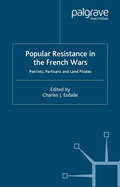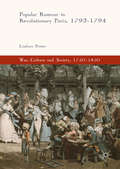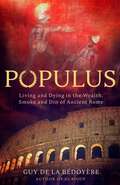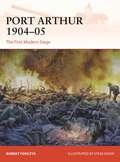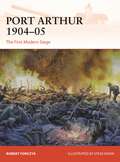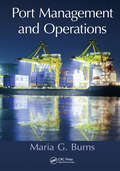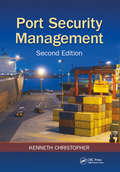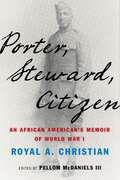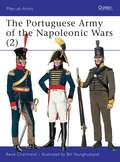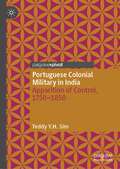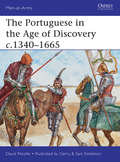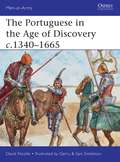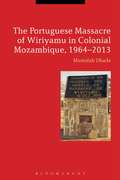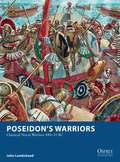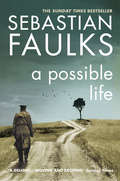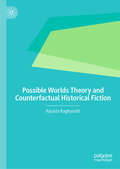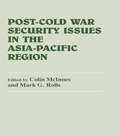- Table View
- List View
Popular Resistance in the French Wars
by Charles EsdaileIn the Napoleonic period warfare ceased to be a matter for armies alone, but also became an affair of the people. So, at least, runs the usual claim. In Spain, Portugal, Italy, Germany and Russia outraged peasants and townsfolk rose against the French armies and fell upon them without mercy. From these insurrections we get the modern word 'guerrilla', but did armed civilians really play an important a role in the struggle? In this collection of essays a group of specialists on the Napoleonic epoch tease out the question, and arrive at some startling conclusions.
Popular Rumour in Revolutionary Paris, 1792-1794
by Lindsay PorterThis book examines the impact of rumour during the French Revolution, offering a new approach to understanding the experiences of those who lived through it. Focusing on Paris during the most radical years of the Jacobin republic, it argues that popular rumour helped to shape perceptions of the Revolution and provided communities with a framework with which to interpret an unstable world.Lindsay Porter explores the role of rumour as a phenomenon in itself, investigating the way in which the informal authority of the ‘word on the street’ was subject to a range of historical and contemporary prejudices. Drawing its conclusions from police reports and other archival sources, this study examines the potential of rumour both to unite and to divide communities, as rumour and hearsay began to play an important role in defining and judging personal commitment to the Revolution and what it meant to be a citizen.
Popular Rumour in Revolutionary Paris, 1792-1794
by Lindsay PorterThis book examines the impact of rumour during the French Revolution, offering a new approach to understanding the experiences of those who lived through it. Focusing on Paris during the most radical years of the Jacobin republic, it argues that popular rumour helped to shape perceptions of the Revolution and provided communities with a framework with which to interpret an unstable world.Lindsay Porter explores the role of rumour as a phenomenon in itself, investigating the way in which the informal authority of the ‘word on the street’ was subject to a range of historical and contemporary prejudices. Drawing its conclusions from police reports and other archival sources, this study examines the potential of rumour both to unite and to divide communities, as rumour and hearsay began to play an important role in defining and judging personal commitment to the Revolution and what it meant to be a citizen.
Populus: Living and Dying in the Wealth, Smoke and Din of Ancient Rome
by Guy de BédoyèreA Time Travellers Guide to Ancient Rome - by one of the best historians of the ancient worldLiving in ancient Rome was superbly and vividly recorded by Rome's historians, philosophers, and poets who were acutely aware of the seething and voluptuous nature of a city that ruled the known world. Through the words of Tacitus, Seneca, Martial, and a host of others including ordinary Romans, Guy de la Bédoyère takes the reader into a world of violent politics, civil disorder, unspeakably brutal entertainments, extravagance, decadence, eroticism, exotica, and staggering inequality, participated in daily by the Roman people from the hyper-rich elite to the lowliest slaves. Populus places those who experienced Rome in person at the forefront of their story, from the rabble-rousing senator Clodius Pulcher to Pliny the Elder and Hortensia who defended the rights of women in court to the ex-slave and celebrity baker Eurysaces.'A superb combination of wit, first-rate research and panache. Highly recommended!' TONY ROBINSON
Port Arthur 1904–05: The First Modern Siege (Campaign #398)
by Robert ForczykA gripping, illustrated narrative of the longest and most brutal land battle of the 1904–05 Russo-Japanese War.Growing rivalry between Imperial Russia and Imperial Japan over territorial control in China and Korea led to the outbreak of war in February 1904. Japan struck the first blow with a surprise naval attack against the anchored Russian Pacific Fleet at its base in Port Arthur. Once the fleet had been neutralized, the Japanese landed their Second Army on the Liaotung Peninsula in May 1904, in order to besiege Port Arthur. The fighting that followed has become legend in military history. Respected military historian Robert Forczyk describes the Russian relief operation towards Port Arthur (the Battle of Telissu), and the lengthy siege of the Russian-held town and harbour. The initial Japanese attempts to capture the port by assault are documented in detail, together with the Japanese progress through the heavily fortified lines protecting Port Arthur. Specially commissioned artworks bring to life in vivid detail the Battle of Nanshan Hill, the Japanese assault on the Wantai Heights, and the bombardments of the Russian forts. Maps and diagrams explore the strategic situation and tactical progress of the fighting in step-by-step detail, and over 60 period photographs reveal the appearance and weaponry of the opposing forces and the terrain around Port Arthur.
Port Arthur 1904–05: The First Modern Siege (Campaign #398)
by Robert ForczykA gripping, illustrated narrative of the longest and most brutal land battle of the 1904–05 Russo-Japanese War.Growing rivalry between Imperial Russia and Imperial Japan over territorial control in China and Korea led to the outbreak of war in February 1904. Japan struck the first blow with a surprise naval attack against the anchored Russian Pacific Fleet at its base in Port Arthur. Once the fleet had been neutralized, the Japanese landed their Second Army on the Liaotung Peninsula in May 1904, in order to besiege Port Arthur. The fighting that followed has become legend in military history. Respected military historian Robert Forczyk describes the Russian relief operation towards Port Arthur (the Battle of Telissu), and the lengthy siege of the Russian-held town and harbour. The initial Japanese attempts to capture the port by assault are documented in detail, together with the Japanese progress through the heavily fortified lines protecting Port Arthur. Specially commissioned artworks bring to life in vivid detail the Battle of Nanshan Hill, the Japanese assault on the Wantai Heights, and the bombardments of the Russian forts. Maps and diagrams explore the strategic situation and tactical progress of the fighting in step-by-step detail, and over 60 period photographs reveal the appearance and weaponry of the opposing forces and the terrain around Port Arthur.
Port Management and Operations
by Maria G. BurnsWith 80 percent of the world’s commodities being transported by water, ports are the pillars of the global economy. Port Management and Operations offers readers the opportunity to enhance their strategic thinking and problem-solving skills, while developing market foresight. It examines global port management practices at the regulatory, commercial, technological, operational, financial, and sociopolitical levels.This powerful sourcebook describes how seaports are being affected by the changes occurring nationally, regionally, and globally. Evaluating the new regulatory framework, it pinpoints the industry’s implementation readiness and identifies potential problem areas. The book classifies the spectrum of interrelated port management principles, strategies, and activities in a logical sequence and under four cornerstones—Port Strategy and Structure, Legal and Regulatory Framework, Input: Factors of Production, and Output and Economic Framework.Detailing best practices and the latest industry developments, the book highlights emerging challenges for port managers and identifies opportunities to develop forward-thinking strategies. It examines the effectiveness of current strategies, tactics, tools, and resources of numerous global ports and highlights the necessity of adopting a proactive stance in harmonizing the laws, regulations, and policies pertaining to the maritime, oil, and gas industries.The shipping industry has myriad complexities and this book provides maritime managers and professionals with the wide-ranging and up-to-date understanding required to thrive in today’s highly competitive and evolving environment.
Port Security Management
by Kenneth Christopher Steven B. FfflmSea and freshwater ports are a key component of critical infrastructure and essential for maintaining global and domestic economies. In order to effectively secure a dynamic port facility operation, one must understand the business of maritime commerce. Following in the tradition of its bestselling predecessor, Port Security Management, Second Edit
Port Security Management
by Kenneth Christopher Steven B. FfflmSea and freshwater ports are a key component of critical infrastructure and essential for maintaining global and domestic economies. In order to effectively secure a dynamic port facility operation, one must understand the business of maritime commerce. Following in the tradition of its bestselling predecessor, Port Security Management, Second Edit
Porter, Steward, Citizen: An African American's Memoir of World War I
by Royal A. ChristianIn 1917, the year the United States entered the Great War, Colonel Moorhead C. Kennedy, one of the most powerful men in the state of Pennsylvania and now the Deputy Director General of Transportation for the American Expeditionary Force, asked his African American valet if he would like to accompany him on an overseas mission. The valet's reaction was "Yes, sir." And he, as he recounted years later, "at once had visions of France." So began Royal Christian's odyssey in Europe. After a tumultuous crossing of the Atlantic as a third class steward on board a British steamship, he survived London's aerial bombing and then celebrated the end of the war in that city's streets. At last, he reached the long anticipated Paris, where he could admire the Eiffel Tower and the astonishing windows of Notre Dame. Royal Christian chronicled his extraordinary experiences in a memoir, Roy's Trip to the Battlefields of Europe, that was privately published in 1919. Rich in historical details, cultural observations, and political reflections, this book is a vital testimony to the history of African American men participating in World War I. After almost a century, Pellom McDaniels III has unearthed this gem, providing an elegantly annotated edition of Christian's memoir. Porter, Steward, Citizen nods both directly and indirectly to the challenges that African Americans encountered in their efforts to serve the cause of freedom and democracy, even as they were denied access to those rights by Jim Crow laws at home. Christian's unique story vividly illustrates how the war helped African American men claim a sense of manhood tied to their military service, and their efforts to transform themselves and their families into full-fledged American citizens. While race often served as a barrier in the army, this book suggests that some black men managed to take advantage of their outsider-within status and thrive: elevating not only themselves but also their community within a society that maintained a deep and abiding attachment to the myth of white supremacy.
Porter, Steward, Citizen: An African American's Memoir of World War I
by Royal A. ChristianIn 1917, the year the United States entered the Great War, Colonel Moorhead C. Kennedy, one of the most powerful men in the state of Pennsylvania and now the Deputy Director General of Transportation for the American Expeditionary Force, asked his African American valet if he would like to accompany him on an overseas mission. The valet's reaction was "Yes, sir." And he, as he recounted years later, "at once had visions of France." So began Royal Christian's odyssey in Europe. After a tumultuous crossing of the Atlantic as a third class steward on board a British steamship, he survived London's aerial bombing and then celebrated the end of the war in that city's streets. At last, he reached the long anticipated Paris, where he could admire the Eiffel Tower and the astonishing windows of Notre Dame. Royal Christian chronicled his extraordinary experiences in a memoir, Roy's Trip to the Battlefields of Europe, that was privately published in 1919. Rich in historical details, cultural observations, and political reflections, this book is a vital testimony to the history of African American men participating in World War I. After almost a century, Pellom McDaniels III has unearthed this gem, providing an elegantly annotated edition of Christian's memoir. Porter, Steward, Citizen nods both directly and indirectly to the challenges that African Americans encountered in their efforts to serve the cause of freedom and democracy, even as they were denied access to those rights by Jim Crow laws at home. Christian's unique story vividly illustrates how the war helped African American men claim a sense of manhood tied to their military service, and their efforts to transform themselves and their families into full-fledged American citizens. While race often served as a barrier in the army, this book suggests that some black men managed to take advantage of their outsider-within status and thrive: elevating not only themselves but also their community within a society that maintained a deep and abiding attachment to the myth of white supremacy.
The Portuguese Army of the Napoleonic Wars (Men-at-Arms)
by René Chartrand Bill YounghusbandOsprey are confident in boasting that this remarkable three-part study will transform the research material available to the English-speaking student of the Peninsular War. Most know that Wellington's Portuguese troops were praised as the 'fighting cocks' of his army; fewer appreciate that they represented between half and one-third of his entire forces. Similarly, most uniform historians have been limited to a few half-understood paintings by Dighton, and brief notes from secondary sources. René Chartrand's recent primary research in Portuguese and British archives now offers a wealth of important new material. This second volume covers the light infantry, cavalry, specialist corps and several supporting military and civilian departments
The Portuguese Army of the Napoleonic Wars (Men-at-Arms)
by René Chartrand Bill YounghusbandOsprey are confident in boasting that this remarkable three-part study will transform the research material available to the English-speaking student of the Peninsular War. Most know that Wellington's Portuguese troops were praised as the 'fighting cocks' of his army; fewer appreciate that they represented between half and one-third of his entire forces. Similarly, most uniform historians have been limited to a few half-understood paintings by Dighton, and brief notes from secondary sources. René Chartrand's recent primary research in Portuguese and British archives now offers a wealth of important new material. This second volume covers the light infantry, cavalry, specialist corps and several supporting military and civilian departments
The Portuguese at War: From the Nineteenth Century to the Present Day (The Portuguese-Speaking World)
by Nuno TeixeiraFrom war campaigns to peacekeeping operations, The Portuguese at War presents an overview of the conflicts, wars and revolutions in which Portugal was involved from the nineteenth century to the present day. From the French invasions to the civil wars, from the African Empire to the wars of decolonisation, from belligerence in the First World War to neutrality in the Second, from participation in the Atlantic Alliance to peacekeeping operations in Kosovo, East Timor, Lebanon and Afghanistan. The book addresses the military interventions in politics and the role of the countrys political regimes in military reform: from the Liberal Revolutions to the Republic, from the military dictatorship and authoritarian regime to the 25th of April Revolution and the transition to democracy. The historical record of Portugals war involvement is not only closely aligned to international and European circumstance but to internal factors: the economy, society, public opinion and political/military power. A historical perspective must of necessity link Portuguese war excursions with the military institutions in place at the time: their recruitment system, social composition and organisation of the army, navy and air force; the military ethos; the evolution of equipment, weapons and military technologies; strategic military doctrine and how this impacted on tactics and military operations; and of course the war outcomes. Special attention is given to the effects of international isolation after the Estado Novo, and post-Cold War europeanisation. The book does not eschew the plurality of interpretative theories. Rather, it seeks to combine historical accuracy of the Portuguese at war within a highly readable literary narrative aimed not only at undergraduate and research levels, but at a broader public audience interested in the complex reach and role of Portugal in world history.
Portuguese Colonial Military in India: Apparition of Control, 1750--1850
by Teddy Y.H. SimThis book explores and analyzes developments in the military institution, military engagements as well as the larger security environment of (including non-war violence and maritime regions linking to) the Portuguese Empire in India. These developments occurred under the onslaught of the early modern globalization. The research shows that far from being dilapidated or archaic, the Portuguese colonial military there kept up with some developments in technology and organization in a competitive environment. Although the colonial military was not the most important reason in accounting for the survival of the Portuguese Estado da Índia, nor was the military profession the most lucrative occupation, the Portuguese experience gave indication of how a colonial state and society was able to survive against coalescing threats from the position of weakness. Located in the period and geographical region of the wax and waning of the Mughal and Maratha empires, Portuguese India was not necessarily a more violent place than the surrounding territories although resistance to and uprising against the Portuguese was usually underestimated. Beginning from the attempt at political and military centralization (and standardization) in the eighteenth century, the abolition of the army of the Estado da Índia in the nineteenth marked nominally the end of an era that may have a reverberation on the pacifist perception of Goa today.
The Portuguese in the Age of Discovery c.1340–1665 (Men-at-Arms #484)
by Gerry Embleton Dr David NicolleFrom humble beginnings, in the course of three centuries the Portuguese built the world's first truly global empire, stretching from modern Brazil to sub-Saharan Africa and from India to the East Indies (Indonesia). Portugal had established its present-day borders by 1300 and the following century saw extensive warfare that confirmed Portugal's independence and allowed it to aspire to maritime expansion, sponsored by monarchs such as Prince Henry the Navigator. During this nearly 300-year period, the Portuguese fought alongside other Iberian forces against the Moors of Andalusia; with English help successfully repelled a Castilian invasion (1385); fought the Moors in Morocco, and Africans, the Ottoman Turks, and the Spanish in colonial competition. The colourful and exotic Portuguese forces that prevailed in these battles on land and sea are the subject of this book.
The Portuguese in the Age of Discovery c.1340–1665 (Men-at-Arms)
by David Nicolle Gerry EmbletonFrom humble beginnings, in the course of three centuries the Portuguese built the world's first truly global empire, stretching from modern Brazil to sub-Saharan Africa and from India to the East Indies (Indonesia). Portugal had established its present-day borders by 1300 and the following century saw extensive warfare that confirmed Portugal's independence and allowed it to aspire to maritime expansion, sponsored by monarchs such as Prince Henry the Navigator. During this nearly 300-year period, the Portuguese fought alongside other Iberian forces against the Moors of Andalusia; with English help successfully repelled a Castilian invasion (1385); fought the Moors in Morocco, and Africans, the Ottoman Turks, and the Spanish in colonial competition. The colourful and exotic Portuguese forces that prevailed in these battles on land and sea are the subject of this book.
The Portuguese Massacre of Wiriyamu in Colonial Mozambique, 1964-2013
by Mustafah DhadaWINNER OF THE 2017 MARTIN A. KLEIN PRIZEIn his in-depth and compelling study of perhaps the most famous of Portuguese colonial massacres, Mustafah Dhada explores why the massacre took place, what Wiriyamu was like prior to the massacre, how events unfolded, how we came to know about it and what the impact of the massacre was, particularly for the Portuguese empire.Spanning the period from 1964 to 2013 and complete with a foreword from Peter Pringle, this chronologically arranged book covers the liberation war in Mozambique and uses fieldwork, interviews and archival sources to place the massacre firmly in its historical context. The Portuguese Massacre of Wiriyamu in Colonial Mozambique, 1964-2013 is an important text for anyone interested in the 20th-century history of Africa, European colonialism and the modern history of war.
The Portuguese Massacre of Wiriyamu in Colonial Mozambique, 1964-2013
by Mustafah DhadaWINNER OF THE 2017 MARTIN A. KLEIN PRIZEIn his in-depth and compelling study of perhaps the most famous of Portuguese colonial massacres, Mustafah Dhada explores why the massacre took place, what Wiriyamu was like prior to the massacre, how events unfolded, how we came to know about it and what the impact of the massacre was, particularly for the Portuguese empire.Spanning the period from 1964 to 2013 and complete with a foreword from Peter Pringle, this chronologically arranged book covers the liberation war in Mozambique and uses fieldwork, interviews and archival sources to place the massacre firmly in its historical context. The Portuguese Massacre of Wiriyamu in Colonial Mozambique, 1964-2013 is an important text for anyone interested in the 20th-century history of Africa, European colonialism and the modern history of war.
Poseidon’s Warriors: Classical Naval Warfare 480–31 BC (Osprey Wargames #14)
by John LambsheadPoseidon's Warriors is a set of wargaming rules for large-scale naval actions between fleets of Classical galleys from the Greek and Persian clash at the battle of Salamis to the battle of Actium that decided the fate of Rome. With so many of these battles taking place around islands or in narrow channels and shallow waters, sneaky tactics and cunning manoeuvres are a hallmark of warfare of this era, and the rules use an integrated turn system to allow a commander to position ships to go in and ram without being rammed in return, or to employ feints and traps to tempt the enemy out of position and leave his ships vulnerable to a follow-up strike. With data for ships throughout the period, rules for famous admirals, historical scenarios, a campaign system and a brief historical summary for those who wish to refresh their memory of the era, Poseidon's Warriors offers everything players need to bring to the tabletop the battles and campaigns of the first great age of naval warfare.
Poseidon’s Warriors: Classical Naval Warfare 480–31 BC (Osprey Wargames)
by John LambsheadPoseidon's Warriors is a set of wargaming rules for large-scale naval actions between fleets of Classical galleys from the Greek and Persian clash at the battle of Salamis to the battle of Actium that decided the fate of Rome. With so many of these battles taking place around islands or in narrow channels and shallow waters, sneaky tactics and cunning manoeuvres are a hallmark of warfare of this era, and the rules use an integrated turn system to allow a commander to position ships to go in and ram without being rammed in return, or to employ feints and traps to tempt the enemy out of position and leave his ships vulnerable to a follow-up strike. With data for ships throughout the period, rules for famous admirals, historical scenarios, a campaign system and a brief historical summary for those who wish to refresh their memory of the era, Poseidon's Warriors offers everything players need to bring to the tabletop the battles and campaigns of the first great age of naval warfare.
A Possible Life: A Novel In Five Parts
by Sebastian FaulksTerrified, a young prisoner in the Second World War closes his eyes and pictures himself going out to bat on a sunlit cricket ground in Hampshire.Across the courtyard in a Victorian workhouse, a father too ashamed to acknowledge his son. A skinny girl steps out of a Chevy with a guitar; her voice sends shivers through the skull.Soldiers and lovers, parents and children, scientists and musicians risk their bodies and hearts in search of connection – some key to understanding what makes us the people we become. Provocative and profound, Sebastian Faulks’s dazzling novel journeys across continents and time to explore the chaos created by love, separation and missed opportunities. From the pain and drama of these highly particular lives emerges a mysterious consolation: the chance to feel your heart beat in someone else’s life.
Possible Worlds Theory and Counterfactual Historical Fiction
by Riyukta RaghunathThis book offers a comprehensive Possible Worlds framework with which to analyse counterfactual historical fiction. Counterfactual historical fiction is a literary genre that comprises narratives set in worlds whose histories run contrary to the history of our world, usually speculating on what would have happened had a significant historical event (such as a war) turned out differently. The author develops a systematic critical approach based on a customised model of Possible Worlds Theory supplemented by cognitive concepts that account for the different processes that readers go through when they read counterfactual historical fiction, a genre which relies heavily on pre-existing knowledge about history and culture. This book will be of interest to anyone working with Possible Worlds, including within the fields of philosophy, literary studies, stylistics, cognitive poetics, and narratology.
Post-Cold War Security Issues in the Asia-Pacific Region
by Colin McInnes Mark RollsThe Asia-Pacific region presents a challenge to international security in the post-Cold War era. Doubts as to the US' military commitment, concern with Japan's security aspirations, build-up of military capabilities and the nuclear ambitions of North Korea have further heightened tension.
Post-Cold War Security Issues in the Asia-Pacific Region
by Colin McInnes Mark G. RollsThe Asia-Pacific region presents a challenge to international security in the post-Cold War era. Doubts as to the US' military commitment, concern with Japan's security aspirations, build-up of military capabilities and the nuclear ambitions of North Korea have further heightened tension.
